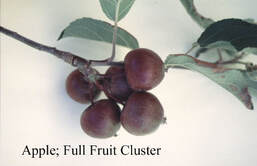
The second benefit of thinning is to promote larger fruit on this year’s crop. Fruit trees are limited in how many fruit they can mature. Too many fruit and fruit size and quality goes down.
A third problem often caused by too many fruit is limb damage. Sometimes the weight of a maturing fruit crop can literally break branches. This is especially common with peaches as peaches only bear fruit on last year’s growth which is on the tips of branches. Thinning will help limit weight and preserve branches.
So how much thinning should we do? Thinning recommendations vary with the type of tree.
Apples and pears: 6 to 8 inches apart. Apples tend to produce fruit in clusters of five. We usually remove all the fruit in a cluster but one. Leave the largest, nicest fruit in the cluster. However, there are times you must remove perfect apples.
Peaches: 6 to 8 inches apart. Peaches tend to cluster together. As long as the average is about 7 inches apart, you will be fine.
Plums and prunes: 4 to 5 inches apart;
Apricots: 2 to 4 inches between fruit.
These are averages and so you may have several fruit clustered closer than this distance. As long as the average on the branch is close to the recommended spacing, the fruit should size well.
Thinning can be done by snapping them off by hand or by cutting them off. If snapping them off by hand, support the fruit stem with your thumb and forefinger and use your other fingers to snap them off. This can be done with one hand with a little practice.
Cherries are not thinned and can produce a full fruit load. (Ward Upham)
 RSS Feed
RSS Feed
